![]()
How QR codes help retailers define Black Friday, Cyber Monday shopper experiences
What if the key to your Black Friday and Cyber Monday (BFCM) success isn’t your 60% off banner but the QR Code you’re using?
According to The Ultimate QR Code Marketing Guide for BFCM, 72% of marketers believe their BFCM campaigns in 2024 were effective. Yet there’s a clear gap when it comes to QR Codes: while brands focus on promoting the biggest discounts, shoppers need more than that.
The problem shows up the moment someone scans a QR Code. Gen Z customers want instant access and product details, while Baby Boomers are more focused on simplicity and security. One income group may expect convenience, while another is driven by value.
As you gear up for your BFCM campaign, pause to consider how QR Code expectations differ across generations, genders, income levels, and regions. Uniqode’s guide article equips you with the information needed to resonate with each shopper and drive long-term loyalty and sales.
What shoppers told us about their QR Code expectations this BFCM
Uniqode’s Q2 survey of 1,000 U.S. shoppers wasn’t about what landed in their carts but about the moments before that. Specifically, how they approach QR Codes during Black Friday and Cyber Monday, what motivates a scan, and where brands fail to deliver on those expectations. (Note: The percentages presented throughout this article reflect responses to multiple, non-exclusive options. Respondents may have selected more than one answer, resulting in an aggregate total that exceeds 100%.)
The survey uncovered a striking gap: while shoppers are increasingly open to scanning QR Codes, the value exchange isn’t always clear.
74% of consumers are likely to scan a QR Code during BFCM, but scanning is not the default; it’s a value-for-action trade.
In fact, 41% of shoppers said they scan primarily for deals or coupons, and 13% are motivated by faster checkout.
However, regarding what they expect post-scan, 56% of shoppers are looking for promotions or discounts, 42% want product information, and 26% want the option to buy online or add to cart.
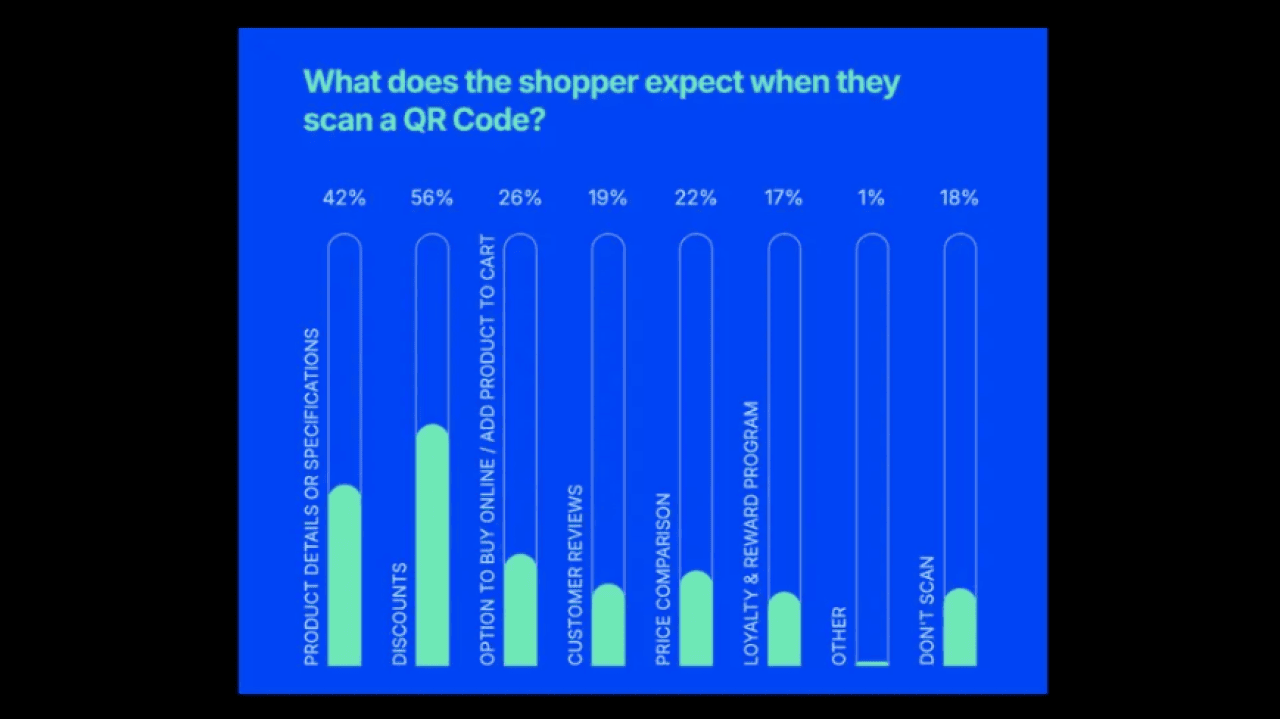
This tells us that brands need to deliver clear, immediate value.
Now let’s look deeper into how different shopper personas, based on age, gender, income, and region, approach the scanning experience.
What shoppers of every generation want from QR Codes this BFCM
Here’s a breakdown of how Gen Z, Millennials, Gen X, and Baby Boomers engage with QR Codes and what they expect from their BFCM experience.
Generation Z (1997–2012)
Gen Z is the most enthusiastic adopter of QR Codes: 86% of Gen Z are open to scanning them, with a strong channel preference for in-store signage (58%) and social media ads (46%). They’re motivated by deals and discounts, with 41% scanning to grab a good offer, and 16% looking for faster checkout options.
But Gen Z doesn’t just scan for any reason; they expect instant value: 47% of them want detailed product information post-scan, while 28% are likely to check customer reviews before deciding to purchase. Brands should note that Gen Z quickly loses interest if the experience isn’t smooth; broken links (41%) or unscannable codes (38%) can result in immediate frustration.
Gen Z prefer QR Code experiences that are fast, value-driven, and information-rich. Any friction risks losing their interest instantly.
Millennials (1981–1996)
Millennials are also very likely to scan QR Codes, with 84% scanning when they see one. Like Gen Z, they engage across multiple touchpoints, particularly in-store signage (62%) and website (40%). While 40% of Millennials scan for deals, convenience is also a significant factor, with 17% scanning to speed up the checkout process.
Millennials expect more than a simple redirect; they want the QR Code to lead them directly to the next step on their shopping journey. Nearly half (48%) scan to get detailed product information, and over a third (34%) want the option to buy online immediately.
Millennials value quick, frictionless paths from discovery to purchase, meaning brands must ensure the content linked through QR Codes aligns with those expectations.
Generation X (1965–1980)
While 74% of Gen X are open to scanning QR Codes, 26% still remain hesitant. This generation still responds best to traditional channels like in-store signage (54%) and printed ads (41%), with social media engagement being lower (25%).
For Gen X, deals are the biggest expectation; 61% of them scan for discounts. However, product details (41%) also play a crucial role.
For Gen X, brands should focus on QR Codes that deliver instant proof of savings and trustworthy details. If the experience feels vague or incomplete, this generation is quick to disengage.
Baby Boomers (1946–1964)
Baby Boomers are the least likely to engage with QR Codes, with only 48% open to scanning them. More than half of Boomers avoid QR Codes altogether, emphasizing the need for more guided experiences. For those who do scan, in-store signage (34%) and printed flyers (29%) are the most effective touchpoints.
Boomers are driven by deals and coupons (38%) and customer reviews (39%). However, trust remains a major barrier, with only 16% feeling confident that QR Codes are safe.
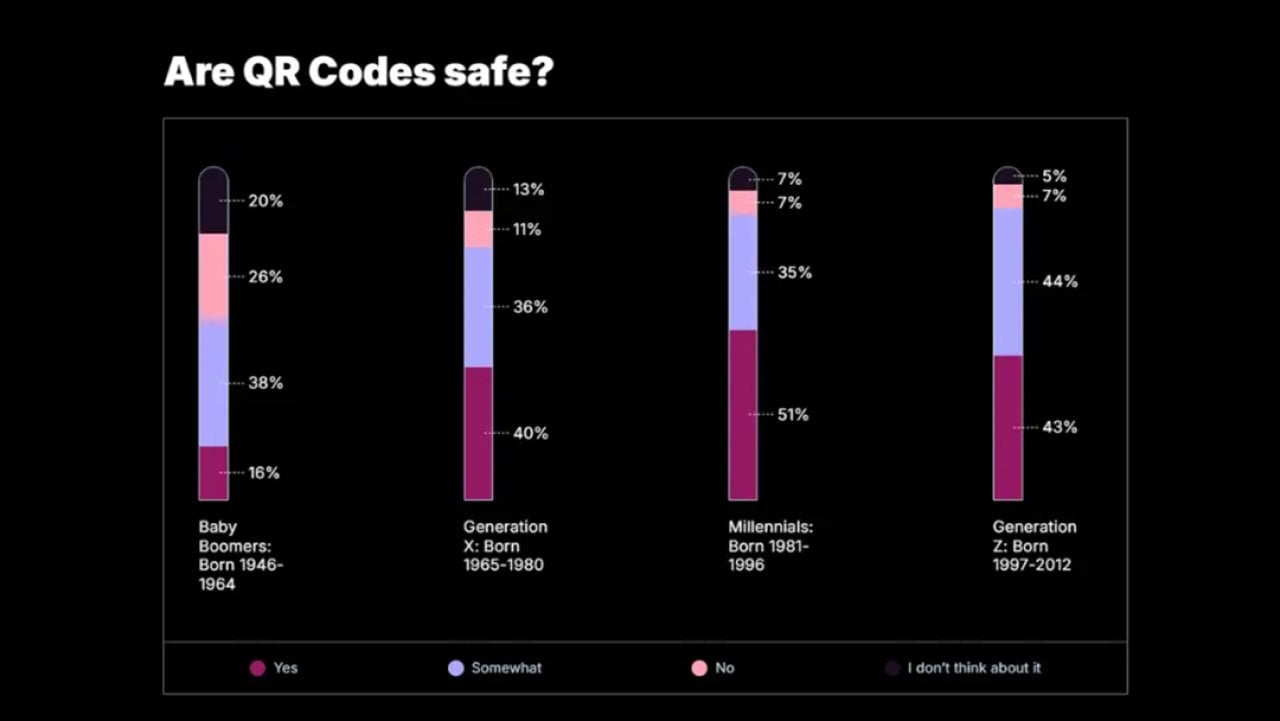
Brands should know that for Boomers, clear instructions and safety assurances are critical to encouraging engagement with QR Codes.
How men and women use QR Codes differently
Shopper motivations also vary by gender, influencing how QR Codes are scanned, trusted, and acted on during BFCM.
The findings below are based on respondents who self-identified as male or female, and they reveal meaningful differences in confidence, safety perception, and preferred touchpoints.
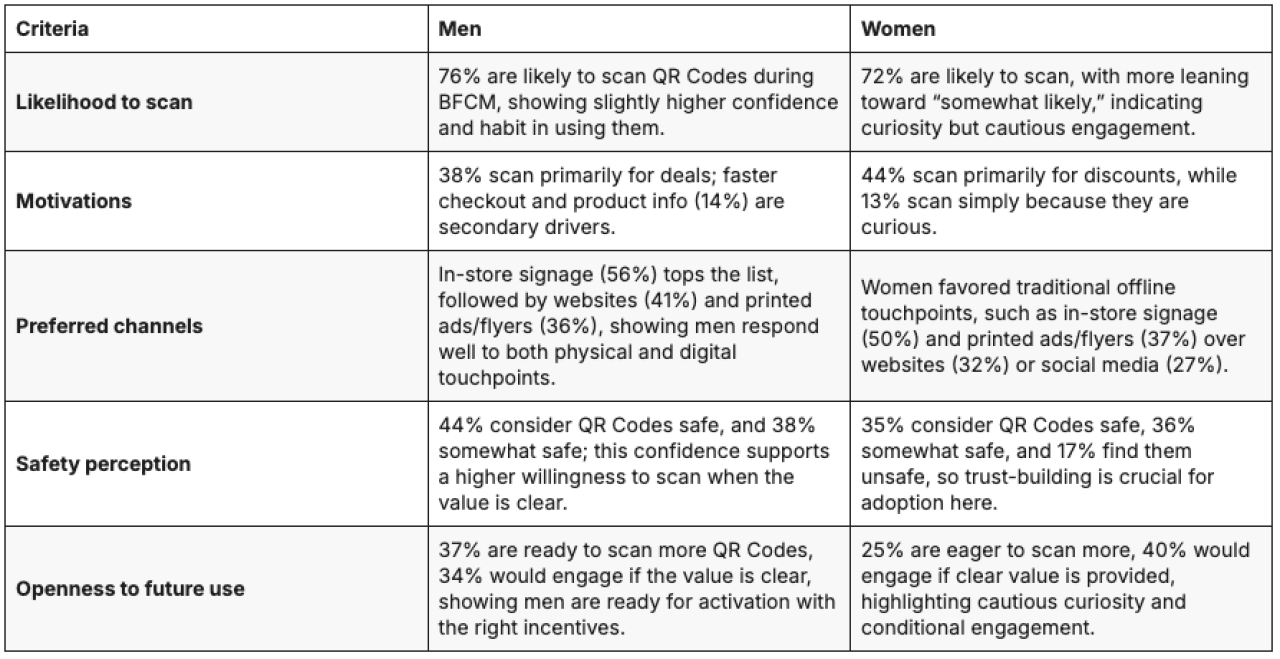
Across income brackets, two elements consistently drive QR Code engagement during BFCM: in-store signage as a top channel and discounts as the leading motivation.
Regardless of spending power, shoppers respond strongly when a scan promises clear savings and is visible at the decision point. However, once they have passed that initial motivator, their behavior changes based on their income.
Group A: Income under $35,000
- Up to 72% are likely to scan QR Codes, especially when clear deals and discounts are involved, and savings are obvious.
- Websites (up to 40%) and social media ads (up to 35%) complement in-store signage.
- Major frustrations include unscannable QR Codes (up to 31%) and broken links (up to 27%).
Group B: Income between $35,000 – $99,999
- Shoppers in this group engage strongly with printed ads and flyers (up to 45%).
- They expect product details (up to 44%) and online purchasing options (up to 31%) after scanning.
- Skepticism exists around QR Code safety, with up to 48% believing them to be only somewhat safe.
Group C: Income $100,000 and above
- This group is highly receptive to QR Codes, with websites (up to 44%) being one of the most preferred channels.
- They seek faster checkout (14%) and product details (49%).
- Poor scan experiences, such as slow-loading pages (up to 34%) or unscannable codes (up to 40%), reduce trust, but they’re open to deeper engagement when value is clear (up to 24%).
How QR Code expectations vary across U.S. regions
Here’s how shoppers in different regions approach QR Codes and what they expect from the shopping experience:
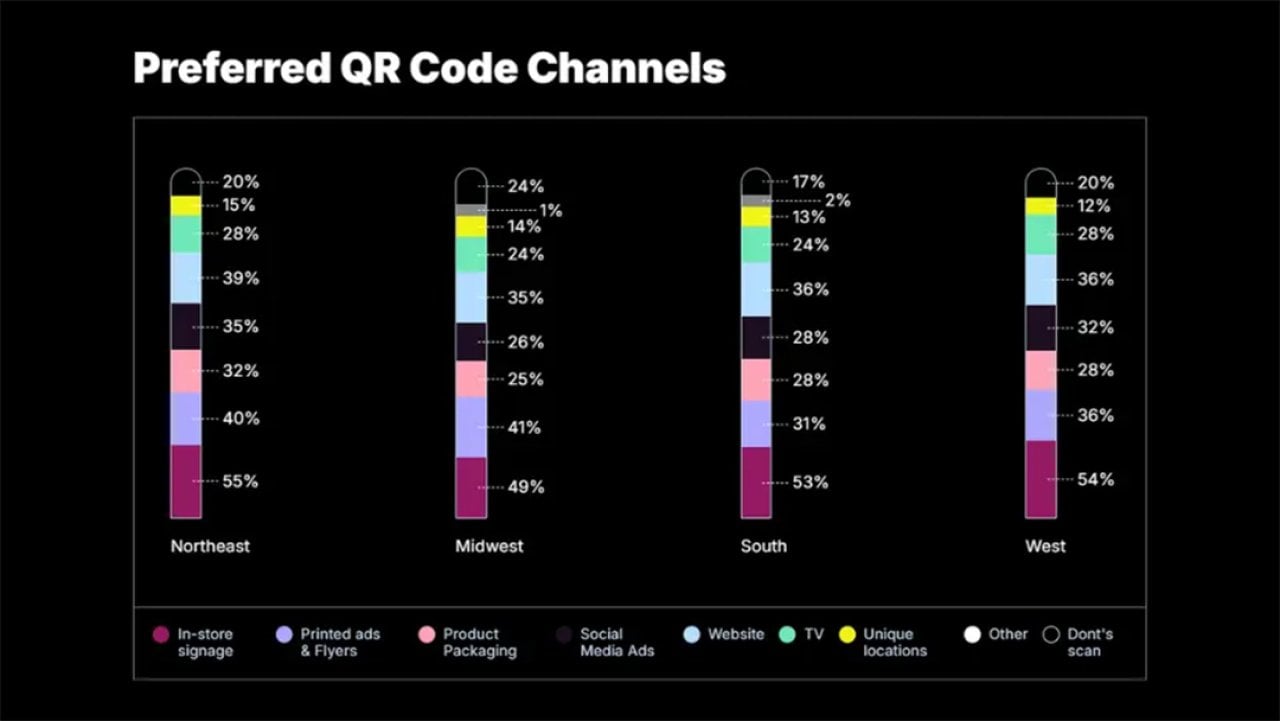
Northeast
- 42% of shoppers are very likely to scan QR Codes, with 38% being open to it, making it the most engaged region.
- In-store signage (55%) and websites (39%) are the most effective touchpoints, showing a combination of physical and digital engagement.
- Deals and coupons drive 48% of scans, with product details (41%) and price comparisons (27%) shaping post-scan expectations.
Midwest
- Less than 30% of shoppers are very likely to scan QR Codes, but 41% are somewhat likely to engage, indicating more cautious behavior.
- Printed ads (41%) and in-store signage (49%) perform best, while websites (35%) are also effective.
- Discounts drive 59% of scans, while 36% shoppers expect product details post-scan.
South
- 31% of shoppers are very likely to scan QR Codes, and 43% are somewhat likely, reflecting good engagement.
- In-store signage (53%) and websites (36%) lead as the most effective touchpoints, with product packaging (28%) also showing potential.
- Deals and coupons (40%) remain the main motivator, supported by faster checkout and curiosity (15%).
West
- 32% of shoppers are very likely to scan QR Codes, with 40% somewhat likely, showing moderate engagement.
- In-store signage (54%), printed ads and flyers (36%), and websites (36%) are the top-performing channels, indicating the effectiveness of a multi-channel approach.
Despite these regional differences, the pain points are similar. Shoppers frequently encounter unscannable QR Codes, slow load times, broken links, and even expired offers.
These issues consistently reduce trust and cut short engagement, underscoring the importance of reliability, speed, and real-time campaign management during the busiest shopping season of the year.
Meeting shoppers where they are
Marketers are hitting their campaign KPIs, but shoppers still walk away unsatisfied. Why? Because execution often falls short where it matters most, i.e., after the scan.
Data from marketers’ own campaigns highlight this gap.
- Timing mismatch: 31% of brands start promotions only 1-2 weeks before BFCM, while early-bird shoppers are already browsing weeks in advance.
- Channel gaps: Even though shoppers are looking for QR Codes on flyers, signage, and packaging, marketers still place them only 6th in channel priority.
- Experience vs. metrics: Revenue (57%) is prioritized over scan data (21%), leaving marketers without visibility into how QR Codes are actually driving engagement.
- Slow iteration: Only 41% analyze campaign data within 1-2 days, limiting their ability to pivot in real time.
The result: shoppers are willing to scan, but the post-scan experience often doesn’t match their expectations.
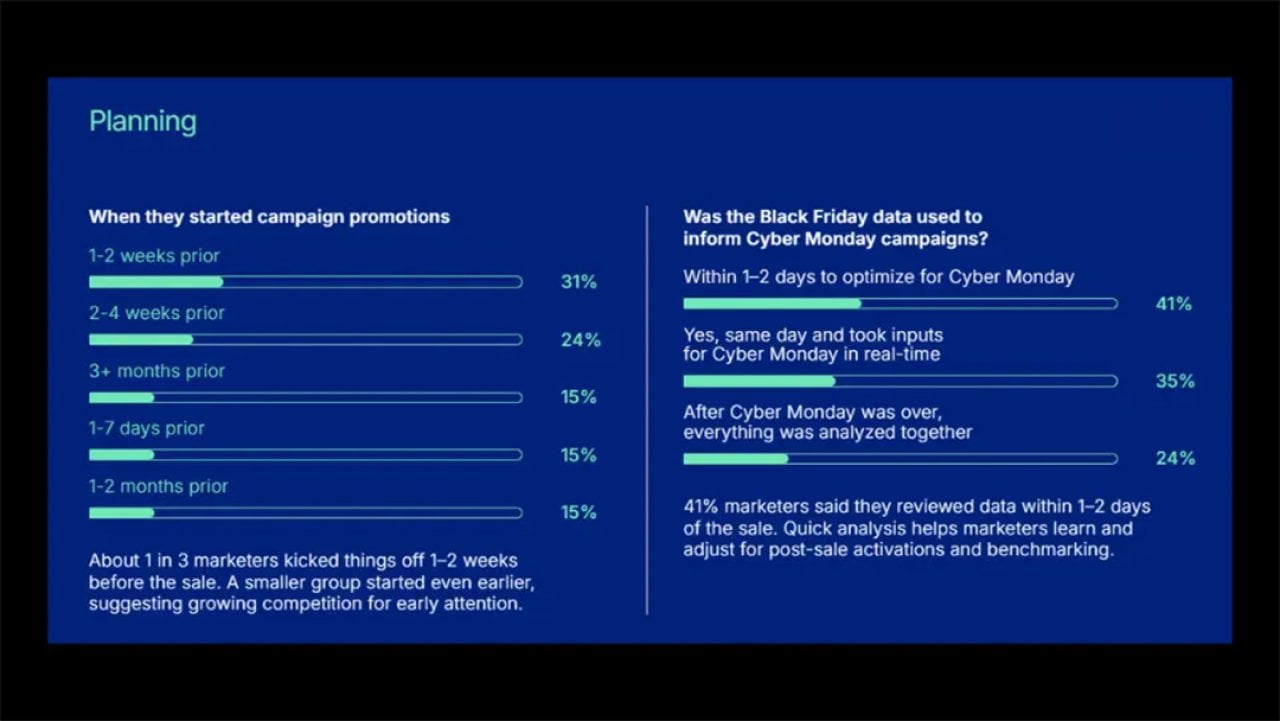
The good news is that these challenges are fixable and provide clear opportunities for brands to outperform competitors this BFCM.
Start early, stay visible
Run QR Code campaigns weeks in advance, especially on the touchpoints shoppers trust most, to reach shoppers before peak weekend traffic.
Optimize the scan-to-experience journey
Every scan should lead to something tangible, such as a time-sensitive discount, instant product details, or a one-tap checkout option. Broken links or expired offers not only lose a sale but also dial down brand trust.
Use real-time insights to adapt
Tracking scan rates and engagement data daily allows brands to double down on what’s working (like flash sales) and quickly fix what isn’t (like a slow-loading page). Marketers who act on these insights in real time will capture far more conversions than those waiting for end-of-campaign reports.
Deliver contextual personalization
Dynamic QR Codes let brands update scan destinations in real time, whether showing region-specific offers, swapping in limited-time bundles, or pointing shoppers to reviews to establish credibility. This makes every scan relevant to the shopper’s context and not just another generic redirect.
Are your QR Codes ready for Black Friday and Cyber Monday?
This Black Friday and Cyber Monday, dynamic QR Codes can boost your conversion rates by delivering personalized experiences that match each shopper’s expectations.
Instead of generic links, your customers get flash discounts, loyalty bonus offers, or limited-time product bundles tailored to their behavior. Real-time dashboards let you see what’s working instantly, so you can double down on high-performing campaigns and pivot away from what’s not converting.
With the benefits crystal clear, the question that remains is: Are you using QR Codes in a way that resonates with your BFCM shoppers?
This story was produced by Uniqode and reviewed and distributed by Stacker.






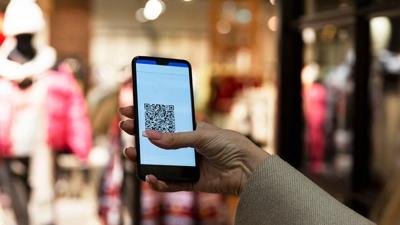














(0) comments
Welcome to the discussion.
Log In
Keep it Clean. Please avoid obscene, vulgar, lewd, racist or sexually-oriented language.
PLEASE TURN OFF YOUR CAPS LOCK.
Don't Threaten. Threats of harming another person will not be tolerated.
Be Truthful. Don't knowingly lie about anyone or anything.
Be Nice. No racism, sexism or any sort of -ism that is degrading to another person.
Be Proactive. Use the 'Report' link on each comment to let us know of abusive posts.
Share with Us. We'd love to hear eyewitness accounts, the history behind an article.